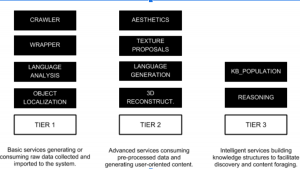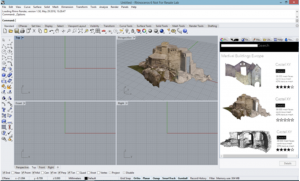The operational prototype describes how assets are created and made available to the users, to be used typically for the design and production workflows of architectural design and video game development. It consists of an integrated system that connects the prototype versions of the services and the authoring tools developed. The platform’s services algorithms are each performing a specific process in the construction and reconstruction of valuable assets. Each of these services is hosted on its own server, and communicate with the other services through exchanged messages over the internet. In a sense, the services complement each other in extracting and constructing new assets.
The tools are essentially a game design tool and an architecture authoring tool, both allow their users to search for assets and inspect them in an interactive manner. The tools do not process data themselves, or in other words they do not build and construct assets, but rather retrieve pre-constructed assets from the platform’s storage
The services of the V4Design platform
According to the architecture of the operational prototype, the platform services can be grouped into three tiers according to their role. This is illustrated in the following Figure.
The service tiers
Tier 1 services are basic extraction and data transformation services that process the content harvested by the platform and prepare it for other more complex services. The Crawler’s task is to search and retrieve media and document from the web, including online repositories and social media websites. The Wrapper connects to well-known online repositories such as Europeana, and indexes their content in the same manner as the Crawler. Language Analysis extracts semantic information from the textual content obtained, and organises it in a manner that facilitates the semantic analysis. Object Localisation looks into images and videos and identifies relevant objects, namely buildings, installations, and others.
Tier 2 services are designed to generated user-oriented assets, such as reconstructed 3D models, short descriptions, textures extract from media, and aesthetics information. Tier 2 services rely on the output of Tier 1 services to perform their tasks. For instance, 3D Reconstruction looks at the objects identified by Object Localization and reconstructs them in 3D. Language Generation uses the semantic information extracted by Language Analysis and builds meaningful and concise description of the content. Texture Proposals analyzes media and tries to identify and extract textures that can be used onto 3D models. Aesthetics complement the work of Object Localization and Texture Proposals by extracting aesthetic information.
Finally, Tier 3 services interlinks all the information generated by other services to construct knowledge structures that connect the elements into meaningful assets. KB Population allows to store and chain together 3D models, descriptions, textures, and other elements. The Reasoning service analyzes how to chain elements together, such as which description applies to which object, or which texture is related to which model.
The user tools in the V4Design platform
The V4Design platform includes two authoring tools, one for virtual-reality game designers and one authoring tool for architects. The game tool is developed on top of Unity, and allows users to create virtual environments, using the assets generated by the V4Design services. Similarly, the architecture authoring tool is based on Rhino 3D, and works as a complete editor for architecture applications. It is also capable of searching and retrieving assets from the V4Design asset repository. The following figure shows a screen capture of the architecture authoring tool.



